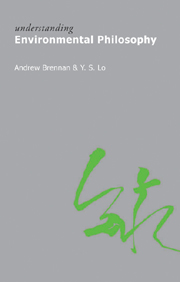Book contents
- Frontmatter
- Contents
- Acknowledgements
- 1 Introduction: the place of environmental philosophy and its basic concepts
- 2 Future generations: what consideration do we owe them?
- 3 Animals: are they as morally valuable as human beings?
- 4 Living things: ethics for the non-human world
- 5 Community: how big is our moral world?
- 6 Natural things: the puzzle of what “natural” means, and whether humans belong to nature
- 7 Foundations: can there be a secular basis for the ideas of human dignity and intrinsic value in nature?
- 8 Origins: political, religious and cultural diagnoses of environmental problems
- 9 Beyond individual responsibility: governance and the affluenzic society
- Questions for discussion and revision
- Further reading
- Bibliography
- Index
6 - Natural things: the puzzle of what “natural” means, and whether humans belong to nature
- Frontmatter
- Contents
- Acknowledgements
- 1 Introduction: the place of environmental philosophy and its basic concepts
- 2 Future generations: what consideration do we owe them?
- 3 Animals: are they as morally valuable as human beings?
- 4 Living things: ethics for the non-human world
- 5 Community: how big is our moral world?
- 6 Natural things: the puzzle of what “natural” means, and whether humans belong to nature
- 7 Foundations: can there be a secular basis for the ideas of human dignity and intrinsic value in nature?
- 8 Origins: political, religious and cultural diagnoses of environmental problems
- 9 Beyond individual responsibility: governance and the affluenzic society
- Questions for discussion and revision
- Further reading
- Bibliography
- Index
Summary
From conception to reality
Singer and Regan, Taylor and Callicott, Leopold, Naess and the new animists: all these theorists have tried to expand our moral universe, widening the circle of our duties and responsibilities to include animals, other living things, and even rivers and mountains. When queried about why we should care about rivers and rocks, Naess would often remark that everyone knew what was meant by saying “Let the rivers run free!”, even though he never espoused any animist or panpsychist views himself. Here is an interesting phenomenon, little discussed in the environmental ethics literature. Once we conceive, or entertain the idea, that dogs and cats are things to which we owe moral responsibility or some kind of respect, then it seems that an argument is required to show why we should not respect these things. Likewise, once we imagine the possibility of trees, flowering plants and fungi having some value in themselves, not just utility for us, then it is easy to conclude that they do have such value. In these cases, we argue from what we have thought about, to what is really the case.
Such arguments have a long history in Western thought, but are generally treated with suspicion. The most famous argument of this sort is the so-called ontological argument for the existence of a supreme being. In its simplest form, the argument goes like this.
- Type
- Chapter
- Information
- Understanding Environmental Philosophy , pp. 113 - 137Publisher: Acumen PublishingPrint publication year: 2010



